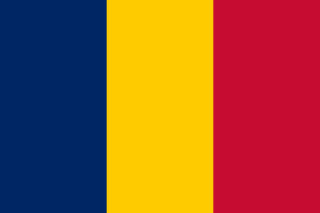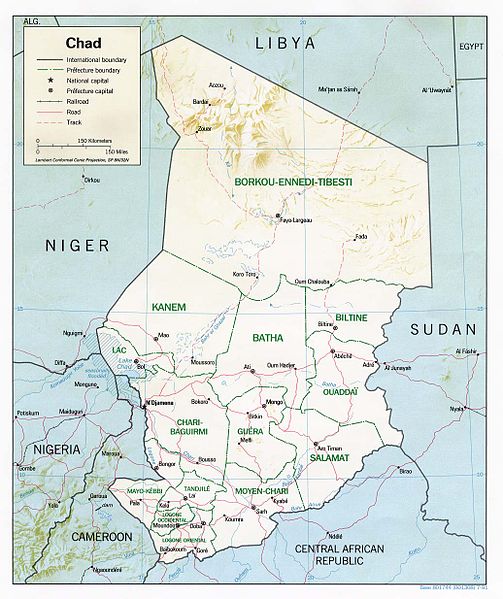"Our" country – We are Chad!
The Republic of Chad
The Republic of Chad (République du Chad) is a landlocked state in Central Africa with six neighbouring countries: Libya, Sudan, Nigeria, Central African Republic, Cameroon and Niger. Chad has a size of about 1.3 million square kilometres (about 3.6 times the size of Germany), which makes it the fifth largest African country. It can be divided into three main regions or climate zones: the Sahara desert zone in the north with hot and arid climate receiving almost no rain, the central semi-desert or Sahel zone with hot and subtropical climate and a wet season from June to September, a nd the humid and fertile Sudanian Savanna zone in the south.
The country is named after Lake Chad, which is the second largest wetland in Africa. Home to 120 species of fish and at least that many species of birds, the lake has shrunk dramatically in the last four decades due to increased water usage from an expanding population and low rainfall. The two major rivers Chari and Logone flow through the southern savannas from the southeast into the lake. Chad’s capital N´Djamena is situated at the confluence of these two rivers.
The country has a population of about 13.6 million with a growth rate of about 3% per year. Due to a very low life expectancy of around 53 years and a fertility rate of 6 children per woman the mean age of the population is only 17. Chadian population is very diverse with more than 200 distinct ethnic groups and over 120 different languages and dialects, Arabian and French being the two official languages. The main religions are Muslim (53%) which mainly live in northern and eastern Chad and Christian (34%) primarily living in the south.
The history of human settlement in the region of today's Chad dates back far. It is said that the territory is in possession of some of the richest archaeological sites of Africa. For instance, in 2002 scientists found a human skeleton, which is 7 million years old. This discovery led to a debate whether Chad is the cradle of human evolution. In the period from 900 until 1900 in the today's region of Chad different empires established, which controlled the area and influenced the political history. These empires received their economic power from the trans-Saharan trade route which led through their territories. The colonial power was France. Their attendance was reduced to the southern parts of the country due to the fertility of the land. France did not have much interest in the country; it was mostly of strategical importance for them. They established a rudimentary infrastructure and education system, but Chad was mainly seen as a source of raw cotton and unskilled labour. They neither attempted to unite the country nor did they work on modernizing it. In 1920 Chad became a self-contained colony. At the beginning of World War II, Chad was the first French colony that accompanied France and the Allies.
 After the war, different political parties were formed. One of their leaders, François Tombalbaye, became the first president of independent Chad. The independence of Chad took place on August 11th in 1960. Around one month later, Chad’s application for membership in the United Nations was admitted. The presidency of Tombalbaye was cruel and dictatorial. He enlarged the gap between the northern and the southern part of Chad, which eventually led to a civil war. This marks the beginning of the collaboration of Chad with Libya's president Muammar al-Gaddafi who supported Tombalbaye. In 1975, Tombalbayes presidency got terminated because of a putsch, which led to his murder. A new government was established, which could not end the riots either and in 1979 another civil war began. Although the civil war ended in 1982, social unrest and political instability continued. In 1990 armed forces under the rule of Idriss Débys marched successfully into the capital city N’Djamena. In 1991 a multi-party system was introduced and Déby was put under oath as the next president of the Republic of Chad. In 1996 the first free elections since the independence in 1960 took place, in which Déby was confirmed as president. Nevertheless, the country found no peace. In 2005 another civil war began between different rebel movements and the government army. The conflict was mainly due to the fact that Chad and its neighbouring country Sudan accused each other of supporting rebel groups each within the other country. In 2010 a peace treaty between Sudan and Chad was signed and ended the civil war.
After the war, different political parties were formed. One of their leaders, François Tombalbaye, became the first president of independent Chad. The independence of Chad took place on August 11th in 1960. Around one month later, Chad’s application for membership in the United Nations was admitted. The presidency of Tombalbaye was cruel and dictatorial. He enlarged the gap between the northern and the southern part of Chad, which eventually led to a civil war. This marks the beginning of the collaboration of Chad with Libya's president Muammar al-Gaddafi who supported Tombalbaye. In 1975, Tombalbayes presidency got terminated because of a putsch, which led to his murder. A new government was established, which could not end the riots either and in 1979 another civil war began. Although the civil war ended in 1982, social unrest and political instability continued. In 1990 armed forces under the rule of Idriss Débys marched successfully into the capital city N’Djamena. In 1991 a multi-party system was introduced and Déby was put under oath as the next president of the Republic of Chad. In 1996 the first free elections since the independence in 1960 took place, in which Déby was confirmed as president. Nevertheless, the country found no peace. In 2005 another civil war began between different rebel movements and the government army. The conflict was mainly due to the fact that Chad and its neighbouring country Sudan accused each other of supporting rebel groups each within the other country. In 2010 a peace treaty between Sudan and Chad was signed and ended the civil war.
In 2011 parliamentary elections took place, which were defined as “free” and “fair” by EU observers. The representatives of the government are elected for 4 years, the president for 5 years. The ruling party is the Patriotic Salvation Movement (MPS), which holds the majority and has the right to amend the constitution.Since January 2015 the Republic of Chad is fighting against the terrorist organization “Boko Haram”.
In the 1960s, the Mining industry of Chad produced sodium carbonate, or natron. However, years of civil war have scared away foreign investors. Before the development of oil industry, cotton dominated industry and the labour market had accounted for approximately 80% of export earnings. Cotton still remains a key export product but investment in the industry is badly needed. In 2000 major direct foreign investment in the oil sector began, boosting the country's economic prospects.Chad's natural resources include gold and uranium. However, the mining sector has yet to receive the same level of investment as the oil industry.
Water-borne diseases such as cholera and malaria pose a significant health risk, particularly in the wetter south but the main risk to health in Chad is malnutrition. Even in good years, a third of the population remains undernourished. Instability and climate change, combined with poverty and rapidly growing population mean that Chadians struggle to feed their families. Nearly two-thirds of people in Chad live below the poverty line and the population remain among the world’s poorest. Over the past decade, child malnutrition rates in the western Kamen region have dipped only once below the World Health Organization’s emergency threshold of 15%. The child mortality rate in Chad is very high. One in five children do not see their fifth birthday.
Although attendance in school at primary level is compulsory, only around three-quarters of children are enrolled in school. Culturally, it is seen as less important for girls to receive an education, often girls are kept at home and are not able to join schools. Due to a shortage of teachers, classrooms are often crowded and sometimes hold up to 100 pupils for lessons. There is also a lack in teaching materials and facilities. Most schools do not have basic services such as running water or electricity. At secondary level, children can study for a further seven years. However, a lack of secondary schools means many children finish their education early. Fewer girls enrol in secondary school, with many marrying early. This means that only 40% of young women between the age of 15 and 24 can read and write.Music and dance play an important role in life of many Chadians.
Music and dance from the South have Black African influences and in the northern parts they are influenced by the Arabian traditions. The National Ballet of Chad was founded in 1970 and enjoys international prestige. The first and only cinema of Chad was opened in 2011 in N'Djaména. The movies of the Chadian film-maker Mahamat Saleh Haroun have won numerous prizes at the Cannes Filmfestival (Festival de Cannes) and were internationally successful. Craftwork plays an important role in daily life of Chadians. It is also used for religious traditions and rituals.
